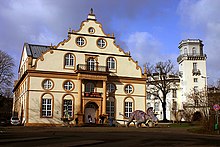Ottoneum
| Naturkunde Museum im Ottoneum | |
 |
|
| Established | 1888 |
|---|---|
| Location | Kassel, Germany |
| Coordinates | 51°18′48″N 9°29′56″E / 51.31333°N 9.49889°ECoordinates: 51°18′48″N 9°29′56″E / 51.31333°N 9.49889°E |
| Type | Natural history museum |
| Visitors | 333,007 (in 2012) |
| Owner | City of Kassel |
| Website |
www |
The Ottoneum in Kassel, Germany was the first theater building built in Germany and is now a museum of natural history.
The Ottoneum was built between 1603-1606 under Landgrave Moritz by the architect William Vernukken. The name 'Ottoneum' comes from Landgrave Motiz's favourite son Otto. With the beginning of the Thirty Years' War (1618-1648) the Ottoneum's heyday as a cultural centre came to an end and the building was put to other uses. It was not until 1696 when the court architect Johann Conrad Giesler converted the building to house the Landgrave art and natural history collection. The work was ordered by Charles I, Landgrave of Hesse-Kassel (Landgrave Karl), and was undertaken by Master Builder Paul du Ry. In 1709 Karl founded the "Collgeium Carolinum", a scientific research centre with famous scholars Georg Forster and Samuel Thomas von Soemmerring at its core. It was during this time that the Ottoneum also housed an anatomical theatre and an observatory. By 1779 the Ottoneum was too small to house the large Landgrave collections and they were moved to the nearby Fridericianum Museum, where it became accessible to the public. A hundred years later when Kassel was a part of Prussia, natural objects were reintroduced into the Ottoneum, which was now under the title of "Preußiches Naturaliemuseum" (The Royal Prussian Kind Museum). The museum has been the Naturkundemuseum (Natural History Museum) since 1928 when possession of the museum was returned to the city. However, in October 1943, during World War II the building was damaged by fire and high explosive bombs, and more than half of the collection was lost. Based on historical plans, they were able to rebuild the Ottoneum again from 1949-1954. Since then, the collection has been increasing through purchases and donations from private collectors. Today the museum is not only a centre for scientific research, but also serves as a platform for discussion related to the protection and conservation of the environment.
...
Wikipedia
